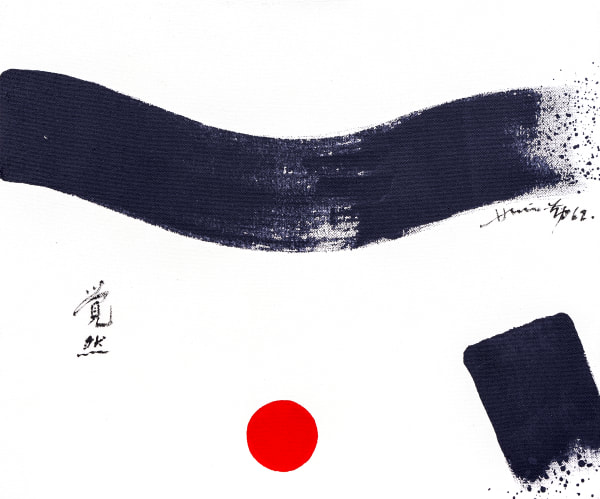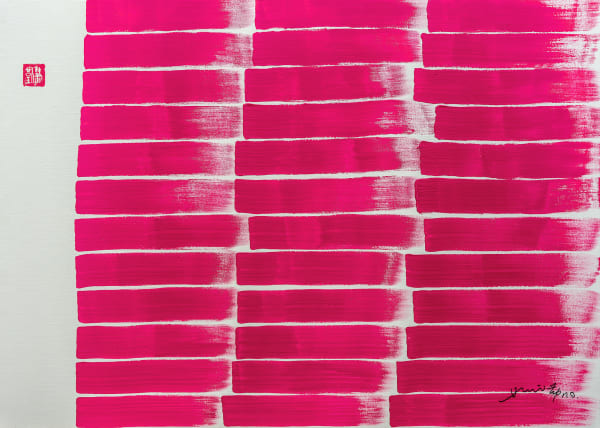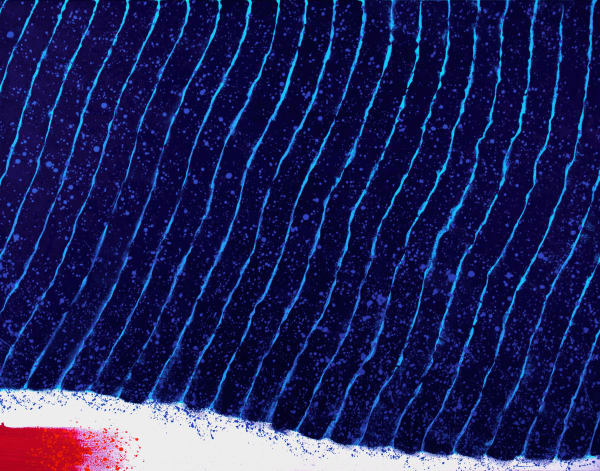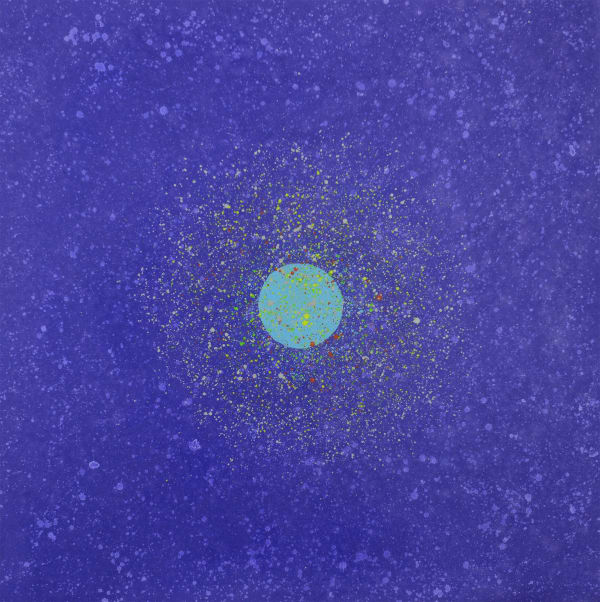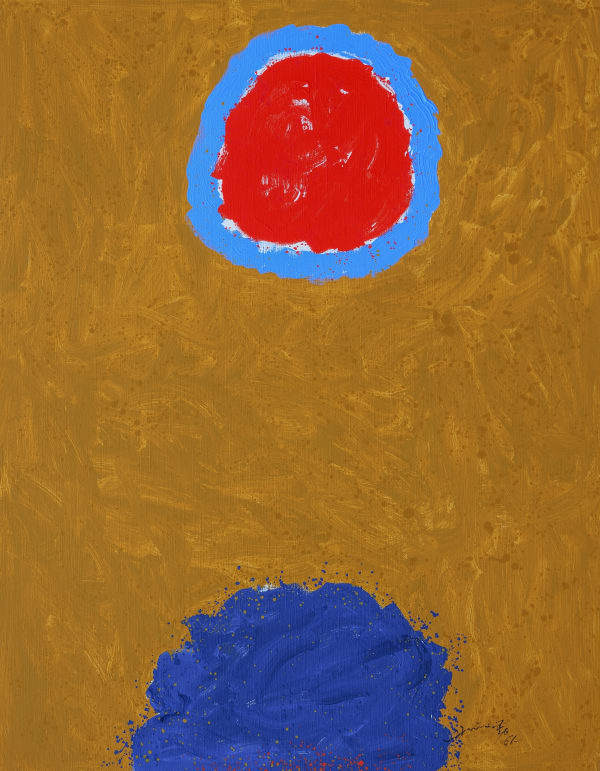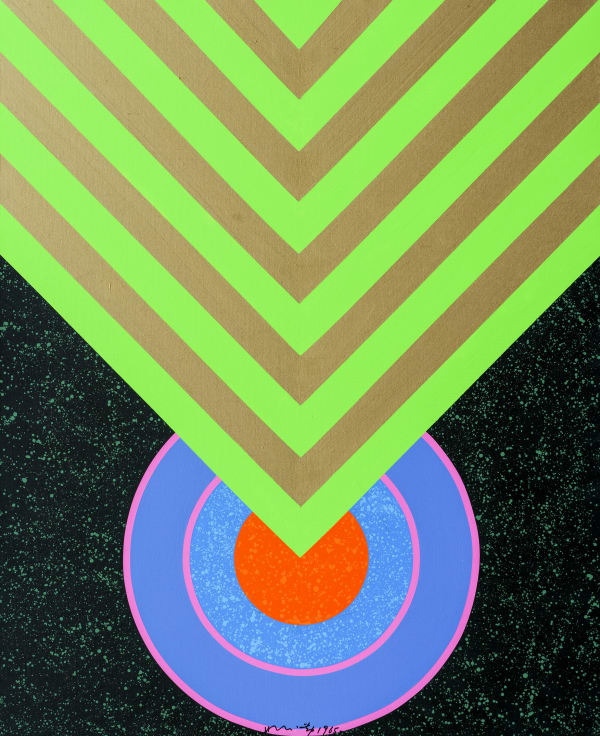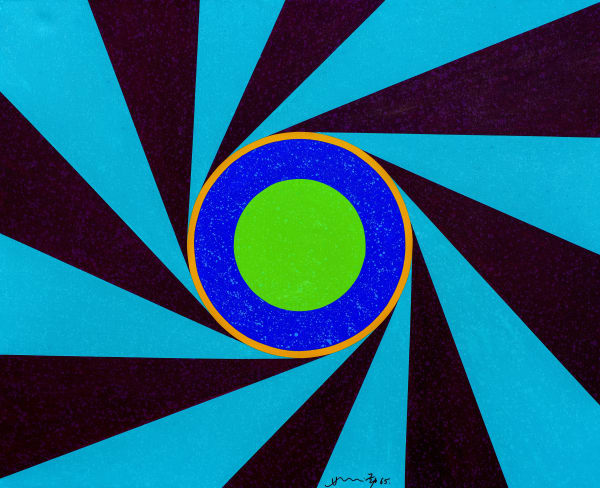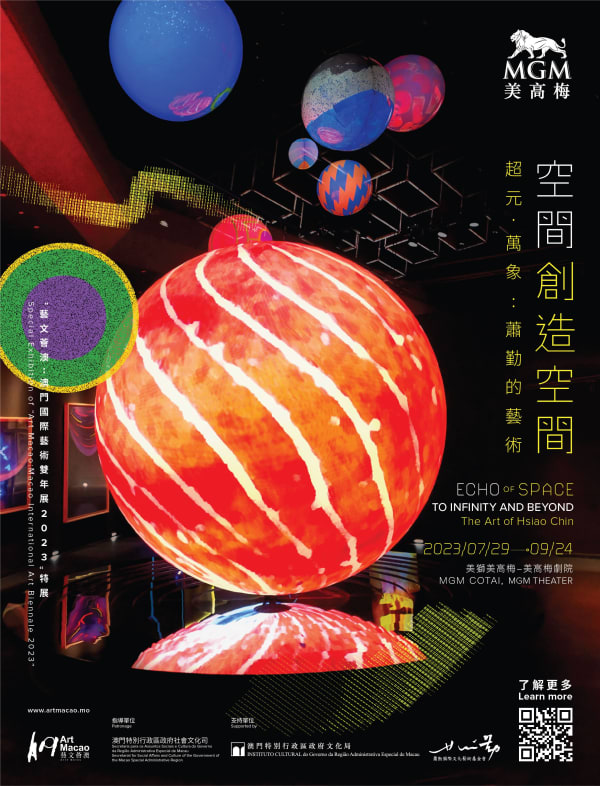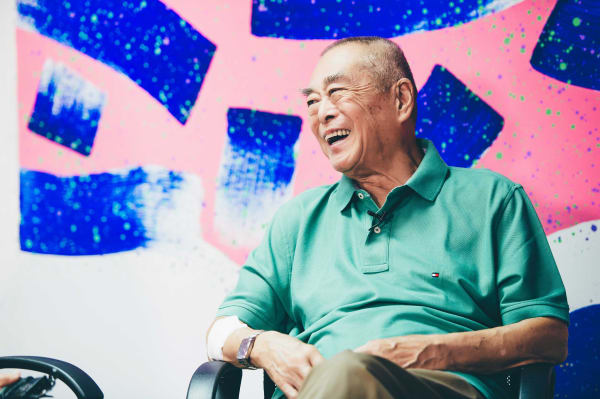Hsiao Chin 蕭勤
'One should always try to explore the limited physical space to the maximum and to generate maximum energy in the confines of space, to learn in a material world that transcends the boundaries of time, and in so doing to grasp the deeper meanings of life. And it is through my awkward brush work and the bright primary colours that I achieve such goals.'
— Hsiao Chin, 2015
Hsiao Chin was born in Shanghai in 1935 and is celebrated as a pioneer of modern abstract art. He is widely recognised in both Eastern and Western art scenes for his major contribution to the development of Chinese modern abstract art. His works can be found in major collections around the world including Metropolitan Museum of Art (New York), M+ Museum (Hong Kong), Musée Guimet (Paris), National Galerie (Rome), Long Museum (Shanghai), Song Museum (Beijing) and MGM Chairman’s Collection (Macau).
Hsiao Chin drew artistic nourishment from his study of traditional Chinese culture and Eastern philosophies and in the 1950s, started to explore abstract art based on his core concept of ‘Eastern Spirit’: the quest for Eastern spirituality and modern artistic expression. In 1955, with a group of artists who shared his aesthetic vision, Hsiao Chin co-founded the Ton Fan Art Group, the first post-war Chinese modern art group, which blended techniques from traditional Eastern art with Western modernism, while promoting Chinese modern art overseas. In 1956, Hsiao embarked on a series of travels in America and Europe, moving first to Madrid and finally settling in Milan, where he lived for over half a century.
Like his senior masters Lin Fengmian and Zao Wou-ki who travelled to France, Hsiao Chin was greatly motivated by Western art during his time in Europe, but developed an interest in Zen and Taoism – in particular the ideas of Lao Tzu and Chuang Tzu – around the 1960s. Drawing artistic nourishment from these studies of traditional Chinese culture and Eastern philosophies, he was capable of understanding and capturing the complex dialects between the void and the solid, strength and weakness. Freely transforming them into his abstract visual language, Hsiao showed great ambition to develop his own style of abstract painting that emphasised the dichotomous nature of the world, and which would be at once distinguishable from, yet reflective of, Western abstract art at that time.
In 1961, Hsiao Chin co-founded the Punto International Art Movement, the first ever international avant-garde art movement initiated by an Asian artist with the aim of promoting Eastern philosophy of ‘calm contemplation’. Whilst living and working in Europe for nearly 60 years, Hsiao Chin strove to integrate his Eastern philosophical thought with his extensive studies of Western aesthetics and his fascination in space science.
His resulting body of works mark key periods in Hsiao Chin’s life, including; 1950s Spain and the influence of Eastern philosophy; 1960s Milan, the birth of Punto and the Universal Energy series; Late 60s New York and Hsiao’s Hard Edge period; his 1980s return to Asia and experiencing modern China; the 1990s Eternal Garden series after the devastating loss of his daughter Samantha; through to 2000s where Hsiao revisited his cosmic theme, continuing his spiritual exploration into the energy of the universe. Hsiao’s oeuvre charts his journey of self-discovery and his spiritual quest for transcendence.
3812 Gallery has represented Hsiao Chin since 2016. In recent years, Hsiao Chin has held major solo exhibitions in Daugavpils Mark Rothko Art Centre (Daugavpils), Musée national des arts asiatiques Guimet (Paris), Song Art Museum (Beijing), and China Art Museum (Shanghai). Most recently Hsiao Chin and Punto, at 3812 Gallery London in 2022, was the artist’s first return to the U.K. since 1966, up to the current day and Hsiao Chin: His Unexplored History at 3812 Gallery Hong Kong.
-
 Il silenzio《靜》, 1962
Il silenzio《靜》, 1962 -
 The Awakening《覺然》, 1962
The Awakening《覺然》, 1962 -
 Dancing Light-15《光之躍動-15》, 1963
Dancing Light-15《光之躍動-15》, 1963 -
 Dancing Light-14《光之躍動-14》, 1963
Dancing Light-14《光之躍動-14》, 1963 -
 Purple Sun (Il sole viola)《紫太陽》, 1964
Purple Sun (Il sole viola)《紫太陽》, 1964 -
 The Illusion of Sun-1《太陽幻覺-1》, 1965
The Illusion of Sun-1《太陽幻覺-1》, 1965 -
 The Hidden Secret《蘊》, 1974
The Hidden Secret《蘊》, 1974 -
 Infiniti Aspetti《眾萬象》, 1979
Infiniti Aspetti《眾萬象》, 1979 -
 Chi-315《炁-315》, 1984
Chi-315《炁-315》, 1984 -
 The Eternal Garden of Mysterious《 神秘的永久花園》, 1995
The Eternal Garden of Mysterious《 神秘的永久花園》, 1995 -
 Meditation of Crossing the Great Threshold-6 (La meditazione sul passaggio di grande soglia-6)《度大限之冥想-6》, 1997
Meditation of Crossing the Great Threshold-6 (La meditazione sul passaggio di grande soglia-6)《度大限之冥想-6》, 1997 -
 Meditation of Crossing the Great Threshold-4 (La meditazione sul passaggio di grande soglia-4)《度大限之冥想-4》, 1997
Meditation of Crossing the Great Threshold-4 (La meditazione sul passaggio di grande soglia-4)《度大限之冥想-4》, 1997 -
 Spiritual Reflection (Proiezione Spirituale-42)《心靈之體現-42》, 2000
Spiritual Reflection (Proiezione Spirituale-42)《心靈之體現-42》, 2000 -
 Chi-5《炁-5》, 2011
Chi-5《炁-5》, 2011 -
 Inner Joy《內悅》, 2014
Inner Joy《內悅》, 2014
-

Abstraction in Dialogue
13 January - 10 March 2025 Hong Kong3812 Gallery is thrilled to present “Abstraction in Dialogue ,” a captivating group exhibition that transcends borders and eras to explore the profound beauty of abstraction in art. Featuring a...Read more -

The Treasure House Fair 2024
Stand 106 27 June - 2 July 2024 Art Fairs3812 Gallery is delighted to participate in the second edition of The Treasure House Fair. Our presentation features a curated selection of works by renowned modern Chinese artists. This includes...Read more -

From Eternal Garden to the Bright Side
Hsiao Chin Memorial Exhibition in Hong Kong 23 May - 31 July 2024 Hong KongIn the previous year, on June 30th, Hsiao Chin (1935-2023) embarked on a journey back to Sirius, a realm where he could reunite with his dearly beloved daughter, Samantha, in...Read more -

Taipei Dangdai 2024 | Remembering Hsiao Chin’s Legacy: a Retrospective of Post-War Abstract Art Across East and West
Evoke Booth E08 9 - 12 May 2024 Art Fairs3812 Gallery announces its participation in Taipei Dangdai Art & Designs 2024 for the first time this year. We will bring a solo exhibition, titled “Remembering Hsiao Chin’s Legacy: a...Read more -

Reaching the Highest
Spring Art Salon 30 January - 1 March 2024 Hong KongIn celebration of the Year of the Dragon, Citi ULTIMA is thrilled to join hands once again with 3812 Gallery to present our spring art project featuring contemporary artists and...Read more -

Gazing at Sirius
Hsiao Chin Memorial Exhibition in Taipei 20 - 22 October 2023 OthersHsiao Chin, Purple Heart, Acrylic on canvas, 160 cm x 390 cm, 2016 E-catalogue In commemoration of the 100 days of Hsiao Chin’s passing, 3812 Gallery presents a memorial exhibition...Read more -

Summer VR Show: Express Yourself
11 August - 2 September 2023 OthersMidsomer's relaxing pleasure of holiday is made more enjoyable with 3812 Gallery's first summer VIP show, 'Express Yourself' . Art inspires and brightens our lives, motivating our imagination to wander...Read more -

To Infinity and Beyond - The Art of Hsiao Chin
MGM Cotai, Art Macau 2023 29 July - 24 September 2023We proudly announce the upcoming grand opening of To Infinity and Beyond: The Art of Hsiao Chin , a special exhibition of Macau International Art Biennale 2023 organised by MGM...Read more -

Treasure House Art Fair
STAND NUMBER 106 22 - 26 June 2023 Art Fairs3812 GALLERY IS PROUD TO JOIN THE TREASURE HOUSE FAIR AT THE ROYAL HOSPITAL CHELSEA, LONDON FROM 22 - 26 JUNE. Two recognized masters of modern European and Chinese art...Read more -

Hsiao Chin: His Unexplored History
15 March - 5 May 2023 Hong KongSupported by Hsiao Chin Art Foundation, this exhibition showcases major paintings of the artist's various transformative periods, from 1958 till present. Hsiao Chin is one of the artists that allows...Read more -

As Water
26 January - 23 February 2023 Hong KongPreface by Dr. Malcolm McNeill 2023 is a water year in the cycle of the five phases. Curator Calvin Hui has taken this to heart in this exhibition, bringing together...Read more -

SPIRIT AND LANDSCAPE
13 July - 10 September 2022 LondonFostering cross-cultural dialogue between East and West, 3812 Gallery brings Spirit and Landscape , the exhibition that celebrates Chinese contemporary artists and beauty of landscape painting across time and space....Read more -

Masterpiece London
30 June - 6 July 2022 Art Fairs, LondonFor Masterpiece London 2022, 3812 Gallery is proud to present Spirit and Landscape, a curated selection of major landscape works from the last one hundred years. One of the most...Read more -

Hsiao Chin and Punto
22 June - 6 July 2022 LondonIn the postwar global artworld, Hsiao Chin’s achievements are both singular and remarkable. He helped to shape the agendas of both European and Asian art; was a member of the...Read more -

Blessings
19 January - 28 February 2022 Hong KongA new year begins and everything starts anew. In Chinese culture, festivals and seasons bring family members together. The renewal of life evolves with the seeding of spring, planting of...Read more -

Hsiao Chin, From Beijing to Paris
Works Exhibited in Major Museums 3 - 28 September 2021Travel and passage from one state to the next are the motif of this 3812 exhibition - as they are of Hsiao Chin's whole art and life. (i) If one...Read more -

Masterpiece Online
23 - 27 June 20213812 Gallery presents dual online and gallery presentations of abstract works by master Eastern artists Hsiao Chin, side by side with paintings from Modern British artist Sir Terry Frost (RA),...Read more -

The Artist as Astronaut: Hsiao Chin
Song Art Museum Beijing 13 March - 13 June 2021 Others'The Artist as Astronaut: Hsiao Chin' is a large-scale retrospective exhibition of Post-war Chinese Abstract artist, Hsiao Chin (b. 1935), to be held at the Song Art Museum, Beijing from...Read more -

Mark Rothko Art Centre presents...
In my beginning is my end: the art of Hsiao Chin 31 July - 25 October 2020In my beginning is my end: the art of Hsiao Chin is the artist’s major retrospective exhibition opening at the Mark Rothko Art Centre in Latvia and running from 31st...Read more -

Masterpiece Online
Hsiao Chin 22 - 28 June 2020 Art Fairs3812 Gallery will participate at Masterpiece Art Fair in London in 2020 for the first time, with a presentation dedicated to Hsiao Chin. Now talking place online on Masterpiece website and its microsite on Artsy, this will showcase influential paintings from throughout the artist's career.Read more -

INK NOW Shanghai: Inquiry on Water
Shanghai Suning Art Museum 1 November 2019 - 31 January 2020 Others3812 REPRESENTED ARTISTS: Hsiao Chin | Wang Jieyin | Wang Huangsheng | Li Lei | Victor Wong INK NOW PROJECT ARTISTS: Liu Kuosung | Qiu Deshu | Wang Tiande |...Read more -

Art Taipei 2019
Punto • Hsiao Chin 18 - 21 October 2019 Art FairsARTIST: Hsiao Chin | Dadamaino Venue: Taipei World Trade Center Hall 1 | Booth H01 Website: 2019.art-taipei.com/taipei/en/Read more -

Hsiao Chin - INFINITE UNIVERSE
Sotheby’s S|2 Hong Kong Gallery 10 September - 9 October 2019 OthersSotheby’s is honoured to present the largest solo exhibition of Hsiao Chin in Hong Kong, “Hsiao Chin – Infinite Universe”, with support from the Hsiao Chin Art Foundation, the artist...Read more -

Hsiao Chin : The Colours of Ch’an
Painting Exhibition 28 March - 30 April 2019 Hong Kong'Ch'an influenced me so much that I decide to abandon Western rationality, seeing it as a restraint, and give full reign to my Asian intuition, so that I could enjoy...Read more -

THE COLOURS OF CH’AN (Les Couleurs du zen)
TRIBUTE TO HSIAO CHIN (Peintures de Hsiao Chin) 13 March - 3 June 2019 OthersProduced with the assistance of the Hsiao Chin International Foundation (Taipei), the exhibition presents a corpus representative of the great moments of the work of painter Hsiao Chin born in...Read more -

Art Taipei 2018
Pulse / Thread 26 - 29 October 2018 Art FairsARTIST: Hsiao Chin | Qu Leilei | Liu Guofu | Chloe Ho | Wang Yichu Venue: Booth K01, Taipei World Trade Center Hall One Website: 2018.art-taipei.com/taipei/ 3812 Gallery is pleased...Read more -

To An Infinite Ascendence
Hsiao Chin Solo Exhibition 16 March - 12 May 2018 Hong KongHsiao Chin has maneuverers between the Eastern and the Western art scene in the past 60 years. From the Ton-Fan Art Group in Taipei to the founding of the Punto...Read more -

Hsiao Chin Coming Home: Retrospective Exhibition
China Art Museum, Shanghai 16 March - 2 May 2018 Others'Despite the ups-and-down in life, my faith will lead my way and prevent me from getting lost.' Hsiao Chin 'I was born in Shanghai in 1935, but as my parents...Read more -

Hsiao Chin: ZEN。ART
Tsz Shan Monastery 3 - 11 February 2018 OthersDEDICATION BY THE ABBOT OF TSZ SHAN MONASTERY VENERABLE THONG HONG Art and Enlightenment In the history of Zen Buddhist tradition, there is a very famous Zen Koan named the...Read more -

Endless Energy
Hsiao Chin Solo Exhibition 2016 16 March - 15 June 2016 Hong KongHsiao Chin (b.1935) is a master artist recognised as a pioneer of Modern Abstract Art in China. He co-founded the Eastern Painting Society in Taiwan in 1956, and has been...Read more
-

Celebrating Hsiao Chin's 90th Anniversary and His Remarkable Legacy
30 January 2025Today, on 30 January 2025, we joyfully commemorate what would have been the 90th birthday of the late Hsiao Chin (1935 - 2023), a pioneering...Read more -

TO INFINITY AND BEYOND - THE ART OF HSIAO CHIN
MGM Cotai, Art Macau 2023 28 July 2023We proudly announce the upcoming grand opening of To Infinity and Beyond: The Art of Hsiao Chin , a special exhibition of Macau International Art...Read more -

Summer Programme 2022
3812 Gallery London 1 June 2022Our London Summer 2022 launches soon and we are bringing East and West ever closer! From 22 June - 6 July Hsiao Chin & Punto...Read more -

Webinar: On Hsiao Chin’s multi-cultural abstract art
How and why are artists who belong to several cultures, both biographically and in art terms, so important to contemporary art and so valuable? 19 August 2021thurSDAY, 26 august 2021 6PM HKT / 11AM GMT | ZOOM WEBINAR Join us in a dialogue with Philip Dodd (renowned British curator and broadcaster),...Read more -

Sotheby's Talks: The Artist as Astronaut- Hsiao Chin
18 March 2021Tuesday 16TH March 5PM HKT The Sotheby's Talks webinar 'The Artist as Astronaut – Hsiao Chin' was held on 16th March. Joining Sotheby’s Felix Kwok...Read more -

WISHING MASTER ARTIST HSIAO CHIN, A VERY HAPPY 86TH BIRTHDAY!
29 January 2021For Hsiao Chin, every day is a new opportunity for artistic exploration…Read more -

Hsiao Chin: The Globetrotting Artist from Everywhere to Nowhere
Artist Hsiao Chin reflects on the many colourful places that have influenced his abstract, multimillion-dollar canvases 17 November 2020Experience Hsiao Chin's geographical biography in Mark Jones's article in Discovery Magazine by Cathay Pacific. 'Hsiao Chin had finally found a point, a purpose. He...Read more -

Press | Wallpaper*: Hsiao Chin and Mark Rothko: a meeting of minds
A new film exploring Hsiao’s practice and global influences released 6 August 2020A major retrospective of pioneering Chinese abstract artist Hsiao Chin's work has opened at the Mark Rothko Art Centre in Latvia. A new film exploring...Read more -

Press | Financial Times: Diary of an art globetrotter
The curator and broadcaster was planning a show of work by Chinese artist Hsiao Chin- then lockdown struck 5 August 2020Published in today’s Financial Times is the article Diary of an art globetrotter written by Philip Dodd, curator of Hsiao Chin’s major retrospective In my...Read more -

Exhibition | Hsiao Chin's Retrospective at Mark Rothko Art Centre Opens Today
In my beginning is my end: the art of Hsiao Chin 31 July 2020The Post-war abstract master Hsiao Chin's major retrospective exhibition In my beginning is my end: the art of Hsiao Chin opens today at the Mark...Read more -

Conversation | Hsiao Chin, Mark Rothko, and the 'Not Only, But Also' Art of Unity
by Sotheby's 1 July 2020Philip Dodd, curator of "In My Beginning Is My End: the Art of Hsiao Chin", sits down with Sotheby’s to discuss the ways in which the art of Hsiao Chin and Mark Rothko converge, and shares insights on the interconnected nature of modern art.Read more -

Press | LUX Magazine Frieze London Special: The new age of ink art
3812 Gallery Co-founder Calvin Hui shares his insights of ink art market 13 May 2020'Navigating the deep waters of the Asian art scene could be treacherous, without a guide such as Calvin Hui.' - LUX Magazine Download the print...Read more -

Press | Artron: When Hsiao Chin comes to Rothko's hometown...
An interview with Hsiao Chin and the curator Philip Dodd 9 March 2020CLICK TO VIEW THE ARTICLERead more -

Press | Cobo Social: Iconic Abstract Artist Hsiao Chin on Love, Art and Spirituality
Renowned Chinese artist Hsiao Chin talks about why his modern abstract art still resonates with audiences today, giving us a glimpse into his artistic language. 27 February 2020A leading figure in Post-War European and Chinese Art, Hsiao Chin, 85, has always been held in high esteem. As one of the artists who...Read more -

Exhibition | Hsiao Chin's 85th Birthday Celebratory Year, 2020
30th January 2020 marked the 85th birthday of renowned abstract artist Hsiao Chin. 30 January 2020A leading figure in Post-War European and Chinese Art, Hsiao Chin spent much of his life in Europe and is celebrated as the only Chinese...Read more -

Exhibition | Sotheby’s Presents Hsiao Chin’s Largest Solo Exhibition in Hong Kong
Hsiao Chin - Infinite Universe 19 August 2019Sotheby's is honoured to present the largest solo exhibition of Hsiao Chin in Hong Kong, 'Hsiao Chin - Infinite Universe', with support from the Hsiao...Read more
-

Tatler Hong Kong | Painting a New Scene
Zabrina Lo, Tatler Hong Kong, 7 November 2023 -

Ming Pao Monthly|Farewell to Hsiao Chin: The ultimate journey of a star in the art world
Ming Pao Monthly, 9 August 2023 -

Phoenix Art | Calvin Hui: In memory of Hsiao Chin through Exhibition in Macau
Phoenix Art, 2 July 2023
-
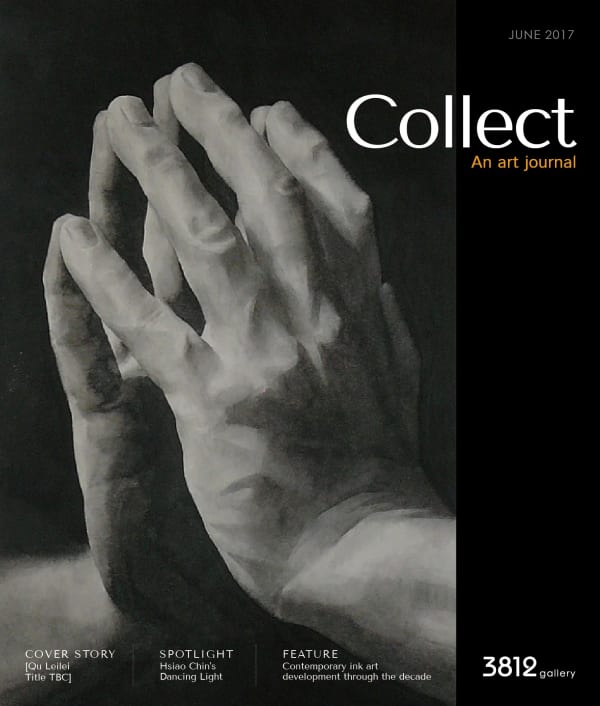 Issue 1 2017Soft Cover, 64 pagesRead more
Issue 1 2017Soft Cover, 64 pagesRead more
Publisher: 3812 Gallery
Dimensions: 300 x 255 mm -

Coming Home
Hsiao Chin 2018Hard cover, 300 pagesRead more
Publisher: China Art Museum
Dimensions: 255 x 215 mm -

Endless Energy
Hsiao Chin Solo Exhibition 2016 Read more -

From Eternal Garden to the Bright Side
Hsiao Chin Memorial Exhibition in Hong Kong 2024 Read more -

Gazing at Sirius
Hsiao Chin Memorial Exhibition 2023 Read more -

Hsiao Chin and Punto
Mapping Post-War Avant-Garde Joshua Gong, 2020Hardback, 192 pagesRead more
Publisher: Unicorn
ISBN: 9781912690831
Dimensions: 290mm x 240mm -

Hsiao Chin: His Unexplored History
Hsiao Chin 2023 Read more -

In my beginning is my end
The Art of Hsiao Chin 2020Softcover, 51 pagesRead more
Publisher: Mark Rothko Art Centre -

Infinite Universe
Hsiao Chin 2019Soft cover, 94 pagesRead more
Publisher: Sotheby's
Dimensions: 218 x 218 mm -

The Artist as Astronaut: Hsiao Chin
2021Soft cover, 139 pagesRead more
Publisher: SONG ART
Dimensions: 250 x 170mm -

The Colours of Ch’an
Tribute to Hsiao Chin 2019Hard cover, 111 pagesRead more
Publisher: Musée national des arts asiatiques - Guimet
Dimensions: 218 x 280 mm -

ZEN。ART
Hsiao Chin 2018Soft cover, 44 pagesRead more
Publisher: Tsz Shan Monastery
Dimensions: 270 x 210 mm
-
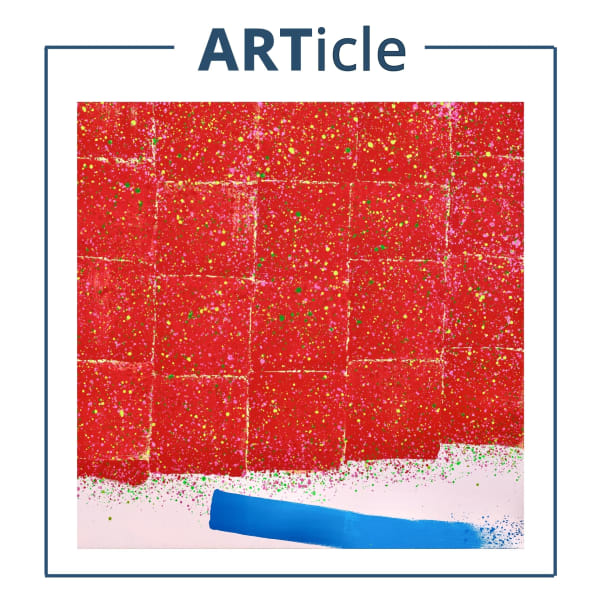
ARTicle | Remembering Hsiao Chin, the Sage of Life
By Karma Dawa Pema Jun 30, 2024The first time I encountered the captivating works of Hsiao Chin Laoshi was seven years ago at 3812 Gallery. As my friend and I stepped...Read more -

ARTicle | A Topological Approach to the Meaning of Life: Retrospect and Prospect of Hsiao Chin’s Art
By Tsai Chao-Yi 17 March 2023For me, the utmost important thing about painting is not the act of painting itself, but to explore the origin of one's life, to record...Read more -
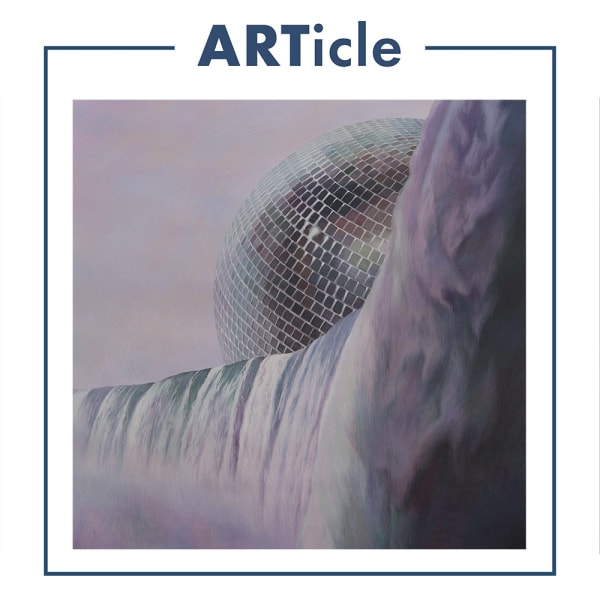
ARTicle | As Water
Dr. Malcolm McNeill 25 January 20232023 is a water year in the cycle of the five phases. Curator Calvin Hui has taken this to heart in this exhibition, bringing together...Read more -

ARTicle | THE SPIRIT OF HSIAO CHIN’S PUNTO
9 June 2022Leading to our upcoming exhibition, Hsiao Chin & Punto , that will open its doors at London gallery from 22nd of June and will include...Read more -

ARTicle | Blessings
19 January 2022In this ARTicle, we would like to introduce Blessings, an artistic theme shrouded with spiritual meaning for the 12 featured artworks, that resonate with different...Read more -
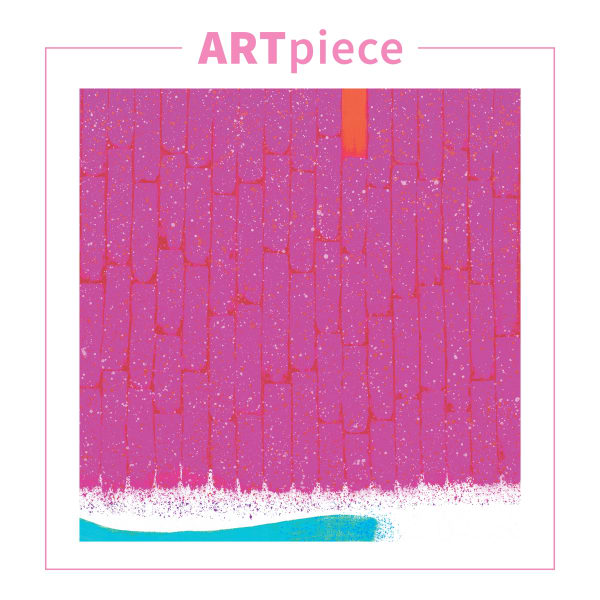
ARTpiece | Hsiao Chin: From Outer Space to a Flowering Earth
6 August 2021Hsiao Chin, SAMANTHA NEL GIARDINO ETERNO-2 , 1999 Acrylic on canvas, 130 x 160cm For this edition of ARTpiece , we will feature the post-war...Read more -

ARTicle | Hsiao Chin's Fundamental Sense of Hope
23 September 2020Hsiao Chin, Light of Divinity-16, 2017, Acrylic on canvas, 110 x 180cm ARTicle is a feature curated by 3812 Gallery, presenting must-read articles by curators,...Read more -

ARTpiece | Hsiao Chin's mosaics
7 August 2020We have enjoyed an exciting week for our 85-year-old master artist, Hsiao Chin. Starting with the opening of his major retrospective exhibition In my beginning...Read more -
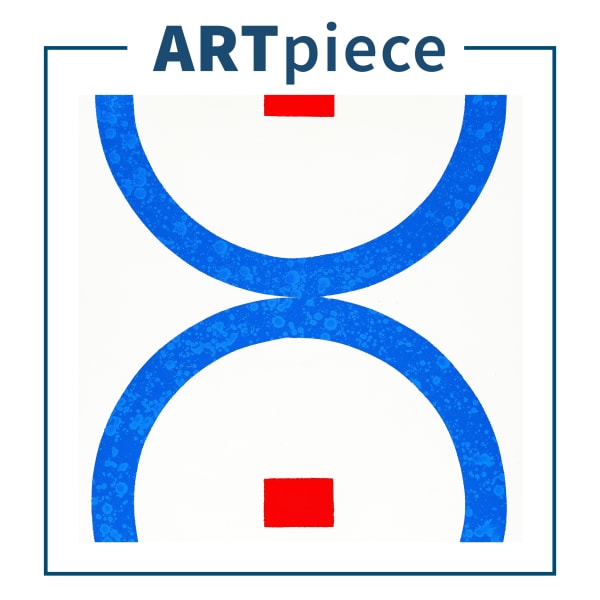
ARTpiece | Hsiao Chin's The Cycles
Jul 24, 2020ARTpiece #6: this week we have chosen to highlight another exemplary artwork from Hsiao Chin's Punto period, The Cycles (1963), to inspire you to add...Read more -

ARTicle | HSIAO CHIN AND THE PUNTO MOVEMENT
2020ARTicle is a feature curated by 3812 Gallery, presenting must-read articles by curators, scholars and art critics focusing on Eastern Origin in Contemporary Expression for...Read more -

ARTpiece | Hsiao Chin's Power of the Light
Jul 10, 2020For ARTpiece #5, we have chosen to highlight Power of the Light, an exemplary artwork from Hsiao Chin's Punto period, as we study his premise...Read more -

ARTicle | Hsiao Chin's Beginnings and Endings
by Philip Dodd 23 June 2020ARTicle is a feature curated by 3812 Gallery, presenting must-read articles by curators, scholars and art critics focusing on Eastern Origin in Contemporary Expression for...Read more -
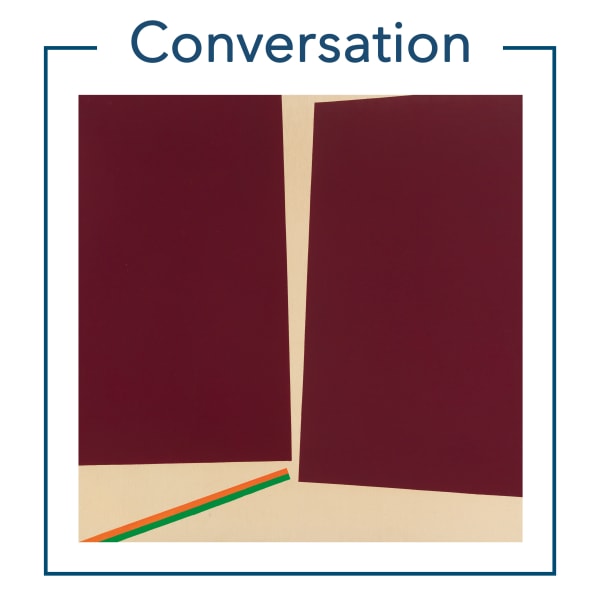
Conversation | A Dialogue with Art History
May 20, 2020Hsiao Chin shared his six-decade artistic journey from Taiwan to Europe and the United States with 3812 Gallery co-founder Calvin Hui. A conversation between renowned...Read more


